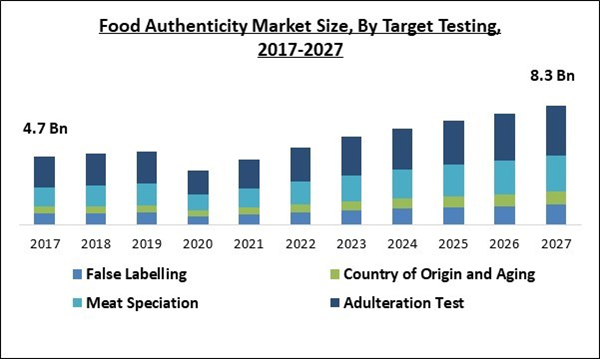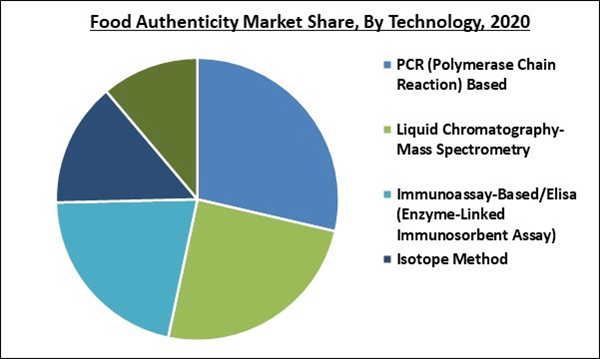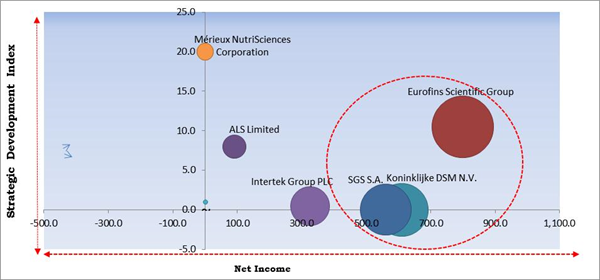The Global Food Authenticity Market size is expected to reach $8,315.6 million by 2027, rising at a market growth of 10.61% CAGR during the forecast period.
Food authenticity is the process of investigating the level of purity in various food and beverage products. Through this process, authorities can evaluate the quality of a given food item by performing various tests in laboratories. It also includes proceeding validation, and usage preference checks to make sure that the validity of the label attached to the product.
There are certain majorly utilized techniques for food authenticity including chromatography, deoxyribonucleic acid (DNA) testing, polymerase chain reaction (PCR), microscopy, immunoassay, and food allergen evaluation.
All these tests help in the identification of purposely substitution, tampering, addition, and distorted representation of ingredients, food, and packaging or any kind of incorrect and misinforming statements associated with the consumption of any product for monetary benefits.
Different analytical methods are utilized for analyzing food contaminants in a sample like illegal dyes that include enzyme-linked immunosorbent assay (ELISA), high-pressure liquid chromatography (HPLC), and thin-layer chromatography (TLC). Furthermore, some other DNA-based methods are used in food testing that includes PCR and DNA sequencing that are utilized to test the substitution of food partly or totally, for example, the usage of DNA barcoding for some varieties detection in meat, fish, and seafood products.
There are several food manufacturers and government departments that use food authenticity testing to uncover the ill practices followed by many food & beverage manufacturers. In addition, various global food organizations are continuously advancing the technologies and methods used for testing a wide range of food samples across the world.
COVID-19 Impact Analysis
There is a negative impact of the COVID-19 pandemic on the food authenticity sector. It is due to the imposition of various restrictions like lockdown, social distancing norms, and others. These regulations have restricted authorities to evaluate food authenticity more effectively like before. The capability of certain testing laboratories was granted owing to the pandemic with the restriction of following social distancing that decreased the accessibility of material & staff.
However, as everything is getting back on track, the demand for food authenticity testing is expected to witness a surge because of the increasing consumer preference towards health & wellbeing that is affected by the pandemic. With the arrival of different variants of coronavirus, companies and governments are setting up policies and standards to maintain a healthy and safe environment for consumers in terms of health safety.
Market Growth Factors:
Increasing cases of food frauds
There is a constant rise in the number of launches took place in the food and beverage industry across the world. Due to this, the risk of food items getting adulterated is also very high. In addition, food frauds are not just limited to the mixing of unethical compounds in the original food composition but also include the distorted or misleading information mentioned on the pack of a food product. For example, if a product label shows that it contains 70% protein content, but, in reality, it might not have this level of protein. Thus, it will fall under food fraud.
Stringent government rules and regulations on food safety
In many developed nations across the world, the regulations and standards for food authenticity are very strict, which is creating lucrative opportunities for the market players to gain a competitive edge in the market. Additionally, governments are becoming more concerned about the safety of food provided to the customers by the manufacturers and thus, there are certain rules and standards that need to be followed by all the food manufacturers.
Market Restraining Factor:
Absence of abundant food control resources and infrastructure
Even after a huge investment by the companies and governments, many countries, especially developing nations, do not have proper food control labs and resources to carry out food testing. The number of food testing or food analysis laboratories and institutions is considerably low in emerging nations, which is restricting the demand for food authenticity testing across these nations. Many countries are observing a shortage in the chemicals used for food analysis.
Target Testing Outlook
On the basis of target testing, the food authenticity market is divided into False Labelling, Country of Origin and Aging, Meat Speciation, and Adulteration Test. The adulteration tests segment acquired the highest share in the food authenticity market in 2020. Food adulteration is one of the major ill activities performed within the food and beverage industry. Many food producers & manufacturers with bad intentions add or substitute inferior compounds to a food item, which reduces the quality of those food items.
Technology Outlook
Based on technology, the food authenticity market is segmented into PCR (Polymerase Chain Reaction) based, liquid chromatography-mass spectrometry, immunoassay-based/ELISA (Enzyme-Linked Immunosorbent Assay), isotope method and others. PCR based segment is anticipated to witness the highest CAGR over the forecast period. In the past few years, numerous methods on the basis of polymerase chain reaction (PCR) have emerged to be useful ways for recognizing species of origin in foods, along with food allergens and genetically modified organisms (GMO). It is owing to the fact that this method offers high specificity and sensitivity, along with swift processing time & reduced cost.
Food Type Outlook
On the basis of food tested, the food authenticity market is classified into Meat & Meat Product, Cereal, Grain, and Pulse, Dairy & Dairy Product, Processed Food, and Others. The processed food segment dominated the food authenticity market with the highest revenue share in 2020. It is owing to a high number of processing applications of products like wine, packaged food, infant formula, and other processed food products. The cases of fraud and counterfeit processed food products are increasing, which is expected to accelerate the demand for food authentication testing services in the market.
Regional Outlook
Based on Region, the food authenticity market is analyzed across North America, Europe, Asia Pacific, and LAMEA. Europe garnered the highest share in the food authenticity market in 2020. It is due to the prevalence of stringent regulations regarding food safety and a huge number of consumer complaints. In addition, the presence of several key market players is and the growing cases of food adulteration is expected to escalate the growth of the food authenticity market over the forecast period.
Cardinal Matrix - Food Authenticity Market Competition Analysis
The major strategies followed by the market participants are Acquisitions. Based on the Analysis presented in the Cardinal matrix; Koninklijke DSM N.V., SGS S.A. and Eurofins Scientific Group are the forerunners in the Food Authenticity Market. Companies such as Intertek Group PLC, Mérieux NutriSciences Corporation and ALS Limited are some of the key innovators in the Market.
The market research report covers the analysis of key stake holders of the market. Key companies profiled in the report include ALS Limited, Koninklijke DSM N.V. (Erber Group), SGS S.A., Eurofins Scientific Group, EMSL Analytical, Inc., FoodChain ID Group, Inc., Intertek Group PLC, Microbac Laboratories, Inc., LGC Science Group Holdings Limited, and Mérieux NutriSciences Corporation (Institut Mérieux).
Recent Strategies Deployed in Food Authenticity Market
- Jul-2021: ALS acquired 49% shares in NUVISAN, a pharmaceutical testing business with operations in Germany and France. The acquisition is expected to further facilitate on the booming Life Sciences division in strategic Food and Pharmaceutical geographies and widen its service portfolio. This acquisition is expected to offer ALS the platform to expand its portfolio from quality control testing to upstream services in research and development.
- May-2021: Merieux NutriScience took over about majority ownership of UCGS, an independent laboratory specializing in food testing in Wei Nan City. Following the acquisition, the company supported its geographical reach in the country in China. The acquisition aimed to support the operations of the company in China and is expected to help to develop a chemistry portfolio in the region for the Traditional Chinese Medicine (TCM) market.
- May-2021: Intertek expanded its geographical reach by introducing its Health, Environmental & Regulatory Consultancy business line in Russia and Spain. Through this, the company can further accelerate its vision to support global companies and their raw materials suppliers to gain access to the Russian and Spanish markets.
- Jun-2020: Eurofins Scientific partnered with QFresh Lab; a company specialized in producing post-harvest quality testing. Following the partnership, the two companies is expected to leverage each other expertise in fresh-cut science & quality and Eurofins food safety testing and technology expertise.
- Jun-2020: Merieux NutriSciences acquired Chestnut Labs, a value-added food safety solutions provider, from Dairy Farmers of America. Through this acquisition, the company increased its service portfolio and expanded its reach in the US as a key market player in food safety.
- Feb-2020: Merieux NutriScience took over CPG Lab, provider of chemical, environmental, and agri-food analysis based in Italy. Following the acquisition, the company enhanced its dominant position in the environment sector for Italy where the company has eight labs.
Scope of the Study
Market Segments Covered in the Report:
By Target Testing
- False Labelling
- Country of Origin and Aging
- Meat Speciation
- Adulteration Test
By Technology
- PCR (Polymerase Chain Reaction) Based
- Liquid Chromatography-Mass Spectrometry
- Immunoassay-Based/Elisa (Enzyme-Linked Immunosorbent Assay)
- Isotope Method
- Other Technologies
By Food Type
- Meat & Meat Product
- Cereal, Grain, and Pulse
- Dairy & Dairy Product
- Processed Food
- Others
By Geography
- North America
- US
- Canada
- Mexico
- Rest of North America
- Europe
- Germany
- UK
- France
- Russia
- Spain
- Italy
- Rest of Europe
- Asia Pacific
- China
- Japan
- India
- South Korea
- Singapore
- Malaysia
- Rest of Asia Pacific
- LAMEA
- Brazil
- Argentina
- UAE
- Saudi Arabia
- South Africa
- Nigeria
- Rest of LAMEA
Key Market Players
List of Companies Profiled in the Report:
- ALS Limited
- Koninklijke DSM N.V. (Erber Group)
- SGS S.A.
- Eurofins Scientific Group
- EMSL Analytical, Inc.
- FoodChain ID Group, Inc.
- Intertek Group PLC
- Microbac Laboratories, Inc.
- LGC Science Group Holdings Limited
- Mérieux NutriSciences Corporation (Institut Mérieux)
Unique Offerings from the Publisher
- Exhaustive coverage
- The highest number of market tables and figures
- Subscription-based model available
- Guaranteed best price
- Assured post sales research support with 10% customization free
Table of Contents
Companies Mentioned
- ALS Limited
- Koninklijke DSM N.V. (Erber Group)
- SGS S.A.
- Eurofins Scientific Group
- EMSL Analytical, Inc.
- FoodChain ID Group, Inc.
- Intertek Group PLC
- Microbac Laboratories, Inc.
- LGC Science Group Holdings Limited
- Mérieux NutriSciences Corporation (Institut Mérieux)
Methodology

LOADING...











